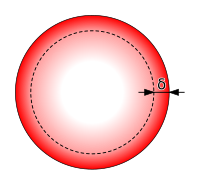
Photo from wikipedia
The International Temperature Scale of 1990 (ITS-90) is commonly expressed in terms of the ratio of the resistance of a standard platinum resistance thermometer (SPRT) to the resistance at the… Click to show full abstract
The International Temperature Scale of 1990 (ITS-90) is commonly expressed in terms of the ratio of the resistance of a standard platinum resistance thermometer (SPRT) to the resistance at the triple point of water. Most high-precision thermometry relies on the alternating current (AC) method due to its manifold practical benefits. However, there are some negative consequences of using AC methods, and it is of particular interest to quantify the effect of the measuring current frequency on the realized temperature of the ITS-90 fixed points. In this work, the effect of the measuring current frequency was investigated by measuring the differences between the AC and direct current (DC) resistance ratios at various fixed-point temperatures. Two AC at 30 Hz and 90 Hz and one DC at a reversal frequency of 3 Hz were used to measure the resistance ratios at four ITS-90 metal fixed points, namely, mercury, water, zinc, and silver; seven SPRTs having different nominal resistances (e.g., 0.25 Ω, 0.6 Ω, 2.5 Ω, and 25 Ω) were employed to explore the effect of frequency on the measured resistance ratio. It was found that the frequency dependence was most noticeable at the freezing point of silver where the insulation leakage and its transient dielectric polarization were expected to manifest themselves the most significantly. For other fixed points, the frequency dependence was found to be insignificant, implying that under normal conditions the benefits of the AC measurements can be fully utilized without affecting the calibration uncertainties of the tested types of SPRTs.
Journal Title: International Journal of Thermophysics
Year Published: 2021
Link to full text (if available)
Share on Social Media: Sign Up to like & get
recommendations!